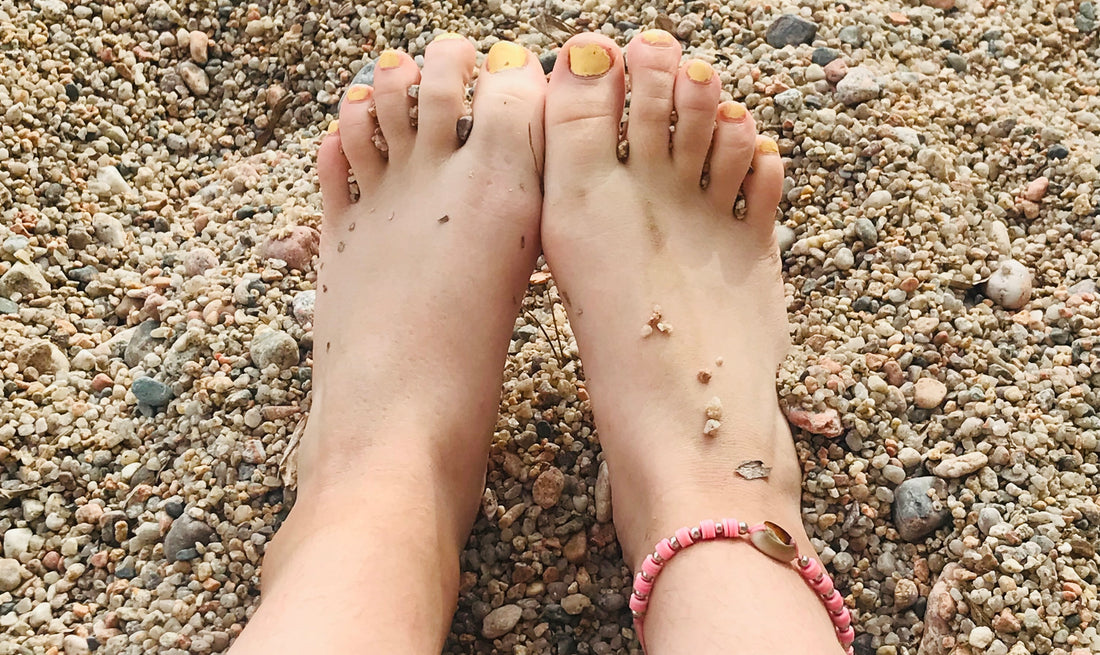
How to Take Care of Children's Growing Feet
Share
Tips to Help Keep Children's Feet Healthy and Strong
Parents are often painfully aware of how quickly kid's feet grow, we've all made frequent and expensive trips to the shoe shop to keep up with growth spurts and new hobbies! But did you know that it can be a false economy to pass on hand-me-down shoes? Preventing bunions and other foot abnormalities is essential and leather is the only material to conform to the shape of a foot and stay there, making it the best possible choice for kids' shoes. Unfortunately this also means that a worn shoe is uniquely shaped to each child, which is why it's never a good idea to pass shoes down to a younger sibling.
Children’s feet develop rapidly and erratically and require proper care and attention to ensure healthy growth. Neglecting foot health can lead to long-term issues affecting posture, mobility, and bone development. To help you keep your child's feet healthy and strong throughout childhood and beyond we've put together some useful tips and expert insight.
Understanding Growth and Development of Children's Feet
Children’s feet grow quickly, especially in the first few years of life. Foot bones in young children are primarily composed of cartilage, which gradually ossifies into hard bone. The rapid growth phases in childhood make little feet vulnerable to external pressures from incorrectly fitted footwear. Tight, ill-fitting shoes can lead to deformities and mobility issues, while poor foot hygiene can cause infections and discomfort.
Importance of Properly Fitting Shoes
Wearing the correct size and type of shoe is crucial for healthy foot development. Shoes that are too tight or loose can cause discomfort, restrict growth and lead to painful conditions such as bunions, ingrown toenails, and long-term postural issues. Poorly fitting shoes can also interfere with natural walking patterns. For example, shoes that are too large may cause children to overcompensate with their gait, leading to muscle strain and discomfort.
Guidelines for Selecting Shoes
A trained shoe fitter will check current shoes and be able to advise on whether the child needs a new pair. Always choose a reputable shop specialising in children's shoes.
- Measure Regularly: Children’s feet should be measured every 8-12 weeks to ensure they are wearing the correct size. Feet should be measured for length and width.
- Room for Growth: Ensure there is about a thumb's width between the child’s toes and the front of the shoe to allow room for growth and natural movement.
- Breathable Materials: Opt for shoes made of breathable materials, such as leather or fabric, which reduce moisture buildup and prevent fungal infections.
- Flexible Soles: Young children’s shoes should have flexible, non-slip soles to allow their feet to move naturally while providing enough grip for stability.
Good Hygene for Children's Feet
Maintaining good foot hygiene shouldn't be overlooked as children's feet will encounter sweat, dirt, and bacteria on a daily basis. This isn't a big deal, it's all part of normal childhood, but good hygiene practices at the end of the day can help prevent infections and skin irritations as well as avoid embarrassment from stinky feet!
Encourage children to take care of their feet with the following:
- Cleanse: Children's feet should be washed daily, using a gentle, sulphate-free, pH neutral cleanser and dried thoroughly. Teach them to pay particular attention to drying between toes to keep damp loving bugs at bay.
- Moisturising: To help with any dry patches, apply a light, non-greasy moisturiser to the feet but avoid the spaces between toes.
- Deodorise: A talc-free powder or deodorant will help feet to feel fresh and dry and extend the life of trainers and shoes. Dandydill Way Liquid Powder is a multi-functional, natural deodorising lotion, specially designed for sensitive skin avoiding harsh chemicals.
- Nail Care: Trim toenails straight across to avoid ingrown nails, and make sure they are kept comfortably short, however only trim the "whites" of the nails to prevent infection.
- Socks and Shoes: Ensure children wear clean socks every day, preferably made of cotton or moisture-wicking materials. Avoid shoes made from synthetic uppers; these don't "breathe" but trap moisture from the feet which will make them uncomfortable and can lead to fungal infections such as athlete’s foot.
Encourage Barefoot Play
Walking barefoot, where it's safe to do so, will strengthen the muscles in the feet, improve balance, and encourage the development of natural foot arches. While it’s beneficial to allow children to walk barefoot indoors or on clean, soft surfaces, it’s important to balance this with wearing proper shoes outdoors to protect their feet from injury.
Look Out For Warning Signs of Foot Problems
- Persistent Red Marks: Red marks on the skin after wearing shoes indicate's that they are correctly fitting, usually too tight.
- Toes Curling or Overlapping: This is a more serious sign but can be caused by improperly fitting shoes. Consult a paediatrician or podiatrist for further advice.
- Walking Abnormalities: Pay attention to how your child is walking. Do they look evenly balanced on both feet?Are feet pointing in or out with weight falling on the inside/outside of the feet? If they start to develop an uneven gait or run awkwardly, the first thing to do is have their feet checked by a qualified professional.
Choosing Footwear for Different Ages
When to buy their first pair of shoes? Once a child is walking most of the day unaided and wants to walk outside then they need a pair of shoes to protect their feet. This usually occurs somewhere between seven months and two years. Never push your child to walk if they're not ready, let them take their time. Starting to walk and becoming more independent is exciting, but can be a bit scary too!
- Toddlers: Look for lightweight shoes with soft, flexible soles to lightly support and protect from rough surfaces. Quick release fastenings are a good idea. Toddlers' first shoes should be firm and snug at the heel to cradle the foot and flexible through the mid and forefoot.
- Pre-schoolers: As children become more active, shoes with slightly firmer soles and better arch support are recommended.
- School-aged Children: Ensure shoes are appropriate for all their different activities. Trainers with good cushioning and support should be worn for sports, while properly fitted and supportive shoes made from natural and breathable materials are ideal for everyday wear. Well-made children's fitted shoes, which are stiff at the back yet flexible at the front, help to support children's feet and keep them balanced.
Children’s foot health is an essential aspect of their overall physical development. Ensuring proper hygiene, regularly checking shoe size, and promoting barefoot play in safe environments all contribute to healthy foot growth. When selecting footwear remember that cotton and leather linings and leather uppers are recommended for their porous (breathable) quality, so moisture is absorbed and allowed to escape. Parents should keep an eye out for any signs of discomfort or irregularities, as early detection and care can prevent future complications and ensure a happy journey into adolescence on two strong feet!
